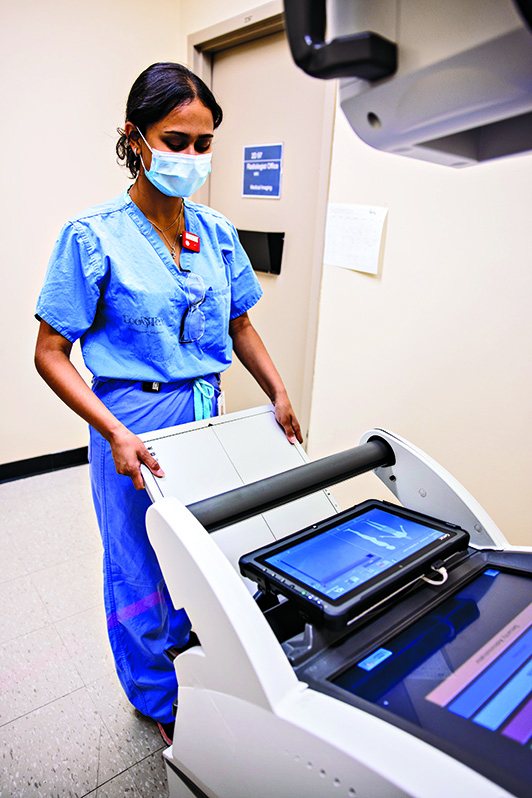Looking to find an alternative medical imaging option that can be easily implemented and provide extra clinical information for the ICU population at the bedside, KA Imaging and Grand River Hospital (GRH) have partnered on an innovative commercialization project supported by the Coordinated Accessible National (CAN) Health Network. Aiming to transform existing hospital workflow for intensive care unit (ICU) imaging, GRH has added KA Imaging’s Reveal 35C, a device that is designed to simultaneously produce both conventional chest X-ray at low dose and higher-contrast spectral radiographic images for improved patient monitoring and faster, more accurate bedside imaging in its ICU.
The hospital has been measuring success metrics around image quality, impact on work processes, and whether follow-up imaging was needed after Reveal’s images. Results have been promising in all areas.
ICU: a challenging environment for imaging
Medical imaging plays a critical role in monitoring the condition of ICU patients, commonly to check for conditions like pneumonia or pneumothorax or to rule out other potentially serious pulmonary issues along with verifying the tips of catheters or endotracheal tubes. Imaging in the ICU can be challenging because of reduced patient mobility, the need for imaging outside regular operating hours, and the need for quick imaging turnaround for bedside decision making.
Generally limited on tissue differentiation, portable chest radiography can be ineffective at accurately spotting complex pulmonary issues and sometimes even to localize the tips of lines and tubes. Other modalities like CT are not portable, bring increased radiation exposure, in addition to risks associated with intra-hospital patient transportation. Furthermore, reimbursement for ICU patients is capitated so an unnecessary CT scan increases cost of care and the financial burden for hospitals.
SpectralDR technology: 3 images, 1 exposure, increased diagnostic information with the same workflow as an X-ray image
The Reveal™ 35C, created by KA Imaging, is a single-exposure, portable, digital dual-energy subtraction X-ray detector. It’s powered by SpectralDR technology, which produces spectral images that separate materials such as water (ie soft tissue, lung lesions etc) and calcium (i.e bones, retained foreign objects, in dwelling devices or other calcifications) and are higher contrast thus, easier to read for a variety of clinicians of varying ability. It also uses the same radiation dose as a traditional X-ray to create the 3 different images without blurring or streaking due to patient movement.
“Dual energy x-ray technology has been around for years, but it’s the first time we can really see the benefit from it at the bedside” explains Carla Girolametto, Director of Innovation and Research at GRH. According to Girolametto, Director of Innovation and Research at GRH, older versions of the dual energy x-ray technology have their limitations, as they need dedicated rooms, require more radiation than traditional X-ray, and can have image quality issues. The high cost of implementation of older technologies also prevents adoption.
According to KA Imaging, Reveal 35C solves these problems and can be retrofitted onto existing x-ray machines, including portable machines – very used in ICU settings.
KA Imaging’s device has been installed on one of Grand River Hospital’s existing portable x-ray machines and has been piloted to help clinicians validate patient tube and line placements as well as monitor the health of patients to prevent
respiratory conditions.
“This is an exciting project and we are pleased to partner with Grand River Hospital to support innovation that will improve patient care and outcomes,” says Amol Karnick, president and CEO of KA Imaging. “This is a great opportunity for Grand River Hospital and KA Imaging to be a showcase for Canadian hospitals, especially the ones that are overburdened and feeling the pressure in their emergency rooms and ICUs” says Karnick.
About KA Imaging and Reveal 35C
Canadian manufacturer KA Imaging specializes in developing innovative X-ray imaging technologies and systems. Reveal 35C is currently available for sale as a retrofit solution in Canada. Coming soon, the device will also be available as part of an integrated mobile system.


